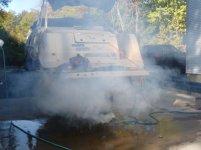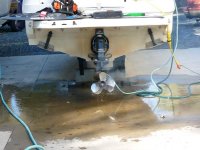I have a 2000 Sea Ray 240DA with a 1yr-old reman'd 5.7L Vortec head marine eng that has a bad oil burning/oil leak problem that only arises when left at idle for several minutes. Since this problem has been happening since the day the engine was installed, it has taken a lot of effort to discount all the possible causes and has lead me to what I have found written below.
I have carefully tested & re-tested with very consistent results and have found the following:
Oil burns/blue smoke(at times billowing profusely) from exhaust outlet and noticeable oil residue in water when engine is allowed to idle for 2-4 minutes or more. If engine is ran at higher RPM (3-4k) out of gear or run in gear above 2k RPM, the blue smoke disappears within 1-2 minutes and does not return unless engine is left to idle for more than 2-4 minutes.
Smoke is much more pronounced if eng is gun'd from idle to higher RPM if after 2-4 minutes of idling. After several minutes of higher RPM and smoke dissipates, engine can be brought back down to idle and gun'd with no smoke at all. Smoke returns if idled for 2-4 minutes.
Each and every time after running engine, fresh oil(slightly blackened) is seen coming from each exhaust manifold gasket at the mating surface at the cyl head on starboard side. I have packed oil soak-up material around all areas of engine and I am confident the oil is only coming from this point. All other gasket areas (oil pan, dips stick, valve cvr, timing cover, etc) all remain very dry. No actual exhaust leak is noticed - carbon/soot/sound. Only oil is noticed dripping from exhaust gasket. Oil will cover 2-3 finger tips with fresh oil after 20-30 minutes of engine running.
I believe the oil burn/oil leak is being caused by the normal higher vacuum at idle and oil is being sucked into the intake cavity at this time and when less vacuum at higher RPM it is not being sucked in.. Does this seem likely or is there something else you would offer to resolve this issue? When I remove the intake manifold to inspect for a gasket breach, is there anything else I should look for in case this is not the problem?
I have carefully tested & re-tested with very consistent results and have found the following:
- All cyls test well with Compression - 150+lbs & leak-down tests - 10-20% max loss.
- Vacuum test steady 19" at idle with increase to 23" during throttle up and then down to less than 5" at higher RPM if out of gear and less than 5" at all RPM above idle while under power. New PCV valve in use, no excess oil residue in it or hose to intake.
- Oil pressure steady at 40-65lbs throughout RPM range increasing with higher RPM.
- Oil level good - never over filled and allowed to get to 1 qt low before refill. - 25W40 Mercruiser oil is in engine.
- Engine power is excellent at all RPM ranges - Idle to WOT of 4700RPM @ 42MPH GPS(45MPH dash gauge) takes only 9secs to achieve top speed. This is a 24ft 5000lb overnight cabin boat.
- No valve tapping or other oil related problems have ever been noticed. Engine has always run very smooth and quiet.
Oil burns/blue smoke(at times billowing profusely) from exhaust outlet and noticeable oil residue in water when engine is allowed to idle for 2-4 minutes or more. If engine is ran at higher RPM (3-4k) out of gear or run in gear above 2k RPM, the blue smoke disappears within 1-2 minutes and does not return unless engine is left to idle for more than 2-4 minutes.
Smoke is much more pronounced if eng is gun'd from idle to higher RPM if after 2-4 minutes of idling. After several minutes of higher RPM and smoke dissipates, engine can be brought back down to idle and gun'd with no smoke at all. Smoke returns if idled for 2-4 minutes.
Each and every time after running engine, fresh oil(slightly blackened) is seen coming from each exhaust manifold gasket at the mating surface at the cyl head on starboard side. I have packed oil soak-up material around all areas of engine and I am confident the oil is only coming from this point. All other gasket areas (oil pan, dips stick, valve cvr, timing cover, etc) all remain very dry. No actual exhaust leak is noticed - carbon/soot/sound. Only oil is noticed dripping from exhaust gasket. Oil will cover 2-3 finger tips with fresh oil after 20-30 minutes of engine running.
I believe the oil burn/oil leak is being caused by the normal higher vacuum at idle and oil is being sucked into the intake cavity at this time and when less vacuum at higher RPM it is not being sucked in.. Does this seem likely or is there something else you would offer to resolve this issue? When I remove the intake manifold to inspect for a gasket breach, is there anything else I should look for in case this is not the problem?



